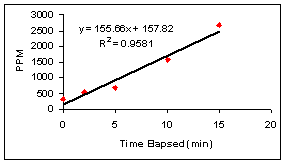
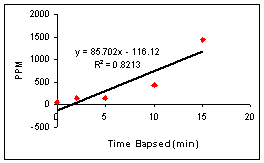
Results and Conclusions
The objective of our first test was to verify that methane is in fact flowing through the system and that the filters are not in fact blocking the free flow gas coming from the vents. One test was performed with the electric fan on, and the other test was performed with the fan off. This way, the influence of the fan on the system is also analyzed. The results for the methane concentration as a function of time is displayed below. The results are of importance to the project in several aspects. First, it is proven that the filter does not block the vents, which was a safety concern that was voiced by the county, and secondly it gives a parameter for the methane production from the landfill and the effectiveness of the fan.


Figure R-1. Methane Concentration Variation with Time for Bio-Filter with Fan off
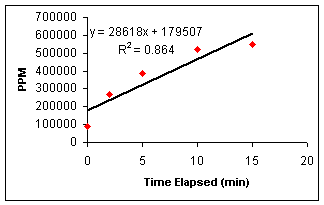
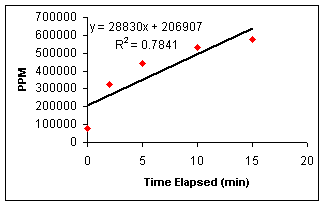
Figure R-2. Methane Concentration Variation with Time for Bio-Filter with Fan on
The above figures show that the methane concentration increases with time. This is exactly the expected result since a cover is placed on the filter and methane starts to accumulate. The slope of the line relates to the flux of methane, then by calculating the total mass and the percentage of CH4 in it, one can calculate the flux in grams. The data shows that the fan doesn't stop flow of methane through system and enhances the amount of methane being released, therefore if forceful ventilation through compost layer is necessary the fan is efficient in doing so.
The methane oxidation tests are performed to analyze the reduction rate of methane through the compost. In other words, this is the testing phase that will define if the filter actually works. The results for the methane oxidation tests are as follows. Table T-1 below shows the oxidation rate on two different test when varying the compost height.
|
Test Date |
|
CH4 ppm/min |
Air Temp |
Volume (m3) |
Chamber Area m2 |
IN FLUX g CH4/m2d |
OUT FLUX g CH4/m2d |
|
Oxidation rate % |
|
|
|
|
|
|
|
|
|
|
|
|
7/26/2004 |
15cm |
91.406 |
27.4 |
148.182 |
0.255047 |
58.23434 |
49.64263 |
|
0.147537 |
|
|
30cm |
38.138 |
27.9 |
108.3948 |
0.255047 |
58.13762 |
15.12615 |
|
0.739822 |
|
|
45cm |
34.208 |
27.5 |
71.41302 |
0.255047 |
58.21497 |
8.950455 |
|
0.846252 |
|
|
|
|
|
|
|
|
|
|
|
|
|
|
|
|
|
|
|
|
|
|
|
7/19/2004 |
15cm |
69.514 |
25.8 |
148.182 |
0.255047 |
58.54601 |
37.95524 |
|
0.351702 |
|
|
30cm |
15.491 |
25.1 |
108.3948 |
0.255047 |
58.68342 |
6.201693 |
|
0.894319 |
|
|
45cm |
12.851 |
24 |
71.41302 |
0.255047 |
58.90066 |
3.402063 |
|
0.942241 |
Table T-1 Methane Oxidation Rate with different Heights of Compost
This first test involves analyzing the oxidation rate of methane by varying the amount of compost. It can be observed that the results are very inspiring, since the reduction rate is almost of 100% when using a compost height of 45cm. It can be seen that the higher the compost column, the more oxidation that takes place.
The second test involves analyzing the oxidation at different points throughout the depth of the compost. Figure R-3 is a graph of the results from the oxidation tests.
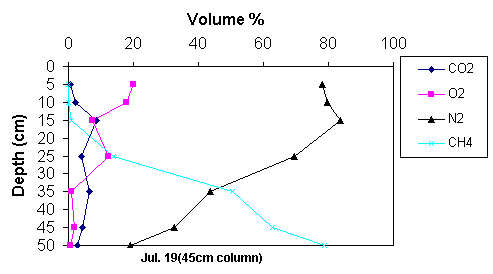
Figure R-3. Oxidation rate at different heights
The results from the figure above shows an impressive reduction in the methane content of the fluid flowing through the filter. From initial concentrations of almost 80% per volume to a final concentration close to 0%, the compost is definitely oxidizing the gas. It can be seen that most of the oxidation is occurring at the deeper depths where the slope (or oxidation rate) is higher. It can also be observed that the concentration of CO2 increases, supporting the idea that oxidation is taking place since CO2 is a product of the chemical process.
In the end, the results for the testing are very encouraging due to the fact that everything in the design proves to be working. There is a large and, most importantly, stable flux of methane. The fan seems to help the flux when the production is low and seems to level it when it is high while large amounts of oxidation is occurring at all levels in the filter, especially the bottom ones, making the design an apparent success by the conducted tests. In conclusion the bio-filter has met all of it's initial expectations and we look forward to creating a trend that ignites the appearance of methane bio-filters worldwide.